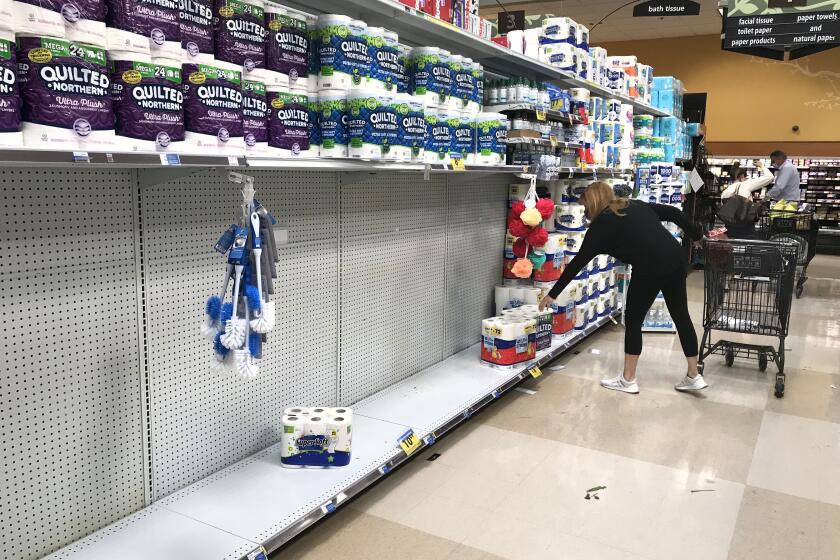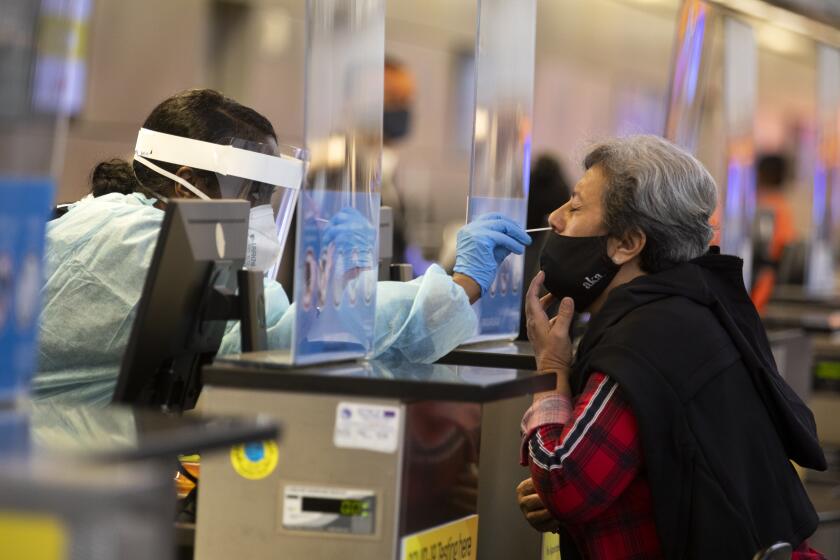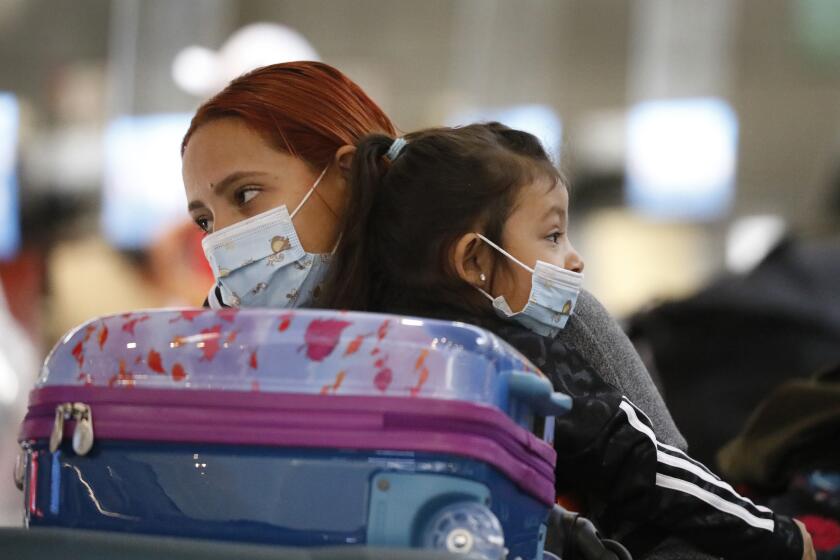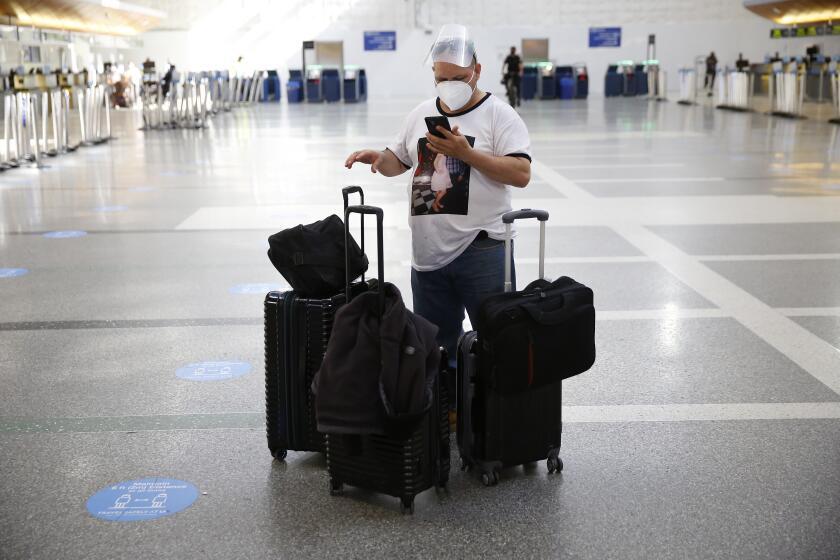L.A. County sees nearly 5,000 new coronavirus infections in a single day, shattering record
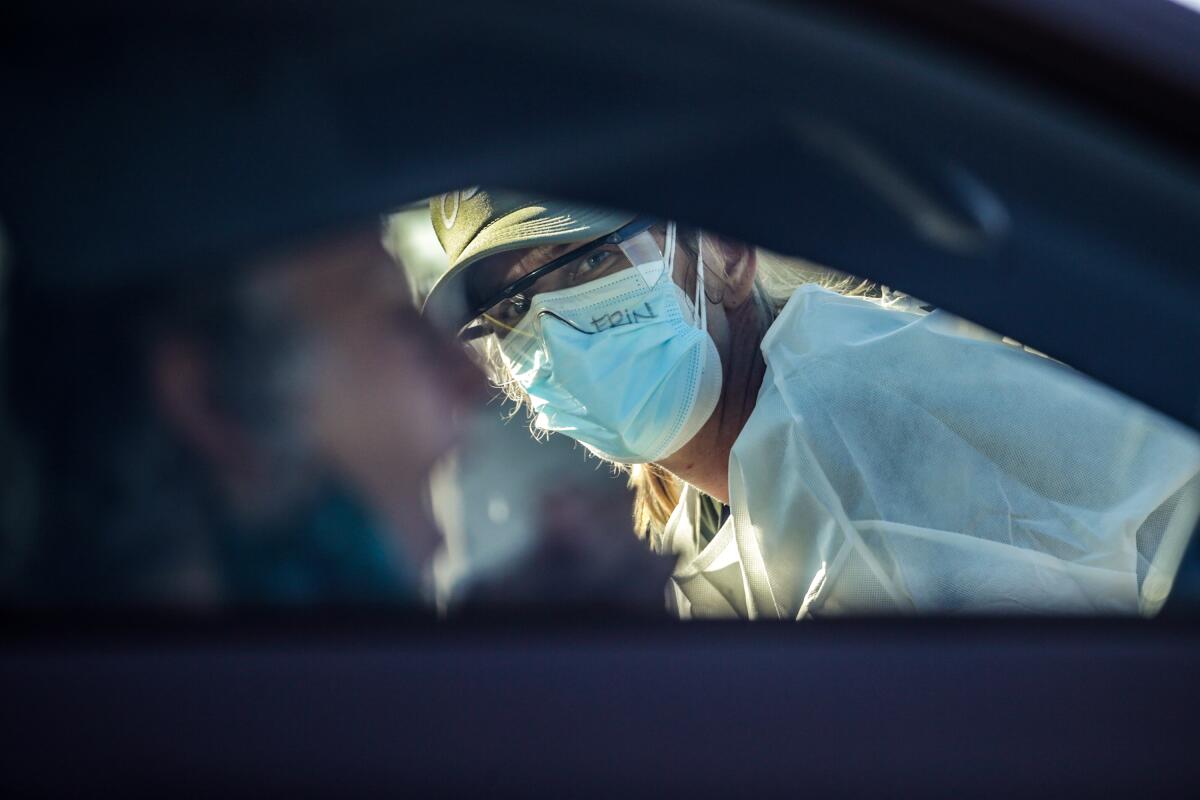
- Share via
Los Angeles County recorded nearly 5,000 new coronavirus cases Thursday, the most it has seen in any one day since the pandemic began, as the state announced that a new, limited stay-at-home order would be put in place starting this weekend that asks people to stay at home between 10 p.m. and 5 a.m., with certain exceptions.
The sheer magnitude of the figure in L.A. County illustrates that the coronavirus outbreak is surging to devastating new heights and underscores that no one should underestimate the extent of its spread, health officer Dr. Muntu Davis said.
“We’re now seeing a much more rapid surge than we saw during the summer,” he said during a briefing.
Gov. Gavin Newsom has announced a stay-at-home order affecting most of California.
An independent Los Angeles Times tally recorded 4,943 new cases Thursday, adding together the latest counts from the cities of Long Beach and Pasadena, which have their own health agencies. Thursday’s count broke the last single-day all-time record of new coronavirus cases, when 4,793 cases were recorded on July 29.
The growth in daily cases is much sharper as the third wave hits Los Angeles County. For the two-week period that ended Thursday, average daily cases over a seven-day period have jumped by 102%, from more than 1,600 cases a day to nearly 3,300 cases a day.
By comparison, average daily cases over a seven-day period only jumped by 77% during the last sharp surge between June 19 to July 2, from about 1,300 cases a day to 2,300 cases a day.
The contrast shows how L.A. County’s third surge could be the most dangerous yet. If the number of new daily coronavirus cases on Friday, Saturday and Sunday remains the same as Thursday’s , L.A. County could cross a red line as early as Sunday that would put the region on the cusp of a new stay-at-home order.
Whether such a new stay-at-home order would happen automatically or wait for a few days hasn’t yet been decided, Davis said.
“It’s really something that we have to discuss,” Davis said. “We’re really hoping that we don’t get there, to have to issue a Safer-at-Home order.”
County officials had hoped to be in a different position at this time of year, seeing improvements in case counts and beginning the widespread reopening of schools. “In all honesty, we never expected or hoped that we would be in this situation at this time of the year,” Davis said.
Officials have started to warn for the first time in months that the county could run out of intensive care unit beds if the surge in cases does not slow.
“At this point, no one should be still underestimating the spread of this virus, nor should anyone be questioning the actions we still need to slow the spread and lessen its impact on our collective health and our local economy,” Davis said.
He urged the public to cancel travel plans and stay home for the holidays; avoid eating at outdoor dining areas at restaurants; avoid crowds by shopping for groceries early in the day or having them delivered; and urged younger adults to volunteer to buy food for neighbors, family and friends who are older or have underlying health conditions.
With the surge in coronavirus transmission in L.A. County, “it is safe to assume that many people are infected without even knowing it yet,” Davis warned. “Right now, the kindest thing we can do for our family, friends and neighbors is to protect each other from potentially becoming infected with COVID-19.”
COVID-19 has already proven itself to be far more dangerous and deadlier than the flu. The last flu season in L.A. County was particularly severe and caused about 3,100 deaths; COVID-19 has already been twice as worse, already resulting in the deaths of 7,364 people in L.A. County since March.
The complications are also proving to be long lasting, Davis said, with serious pneumonia causing lasting damage to the lungs that result in long-term breathing problems, as well as cause lasting damage to the heart muscle, even in people who experience only mild COVID-19 symptoms. “It is possible this could increase the risk of heart failure or other heart complications in the future,” Davis said.
Ahead of any such action at the county level, though, the state issued a new, limited stay-at-home order that will prohibit nonessential work and gatherings between 10 p.m. and 5 a.m. in counties that are in the most restrictive tier of the state’s coronavirus reopening blueprint.
As of this week, 41 counties representing roughly 94% of the state’s population, including Los Angeles, were in that “purple” tier.
Officials said Thursday afternoon that the order will take effect at 10 p.m. Saturday and remain in place for one month.
California is “seeing this surge growing faster and faster, and we must address it immediately,” according to Health and Human Services Secretary Dr. Mark Ghaly.
“We aren’t sure where the peak will be, so that is why we certainly need to be laser-focused on all things we can do collectively across the state,” he said.
The order prohibits most nonessential activity outside the home from 10 p.m. to 5 a.m. in counties in the strictest tier of the state’s reopening road map. It begins Saturday.
Davis also announced that there are 1,238 COVID-19 patients now hospitalized countywide, a figure that has steadily increased in recent weeks.
During his briefing Thursday, Ghaly shined a spotlight on L.A. County’s rapidly swelling case rate, saying “all signs point to continued rise in that number.”
Though infections are skyrocketing at a rate the county has never seen, Davis pointed to the response to the previous summertime surge as evidence that — through collective caution and vigilance — the community can turn things around.
“It is possible to do that again,” he said, “but it takes each and every one of us, regardless of our beliefs, regardless of what we think, to follow the practices that we know slow the spread of this virus and will help to limit the daily case counts that we’re seeing now and the hospitalizations and deaths that we’ll see that come from those.”
Beyond L.A. County, coronavirus cases are increasing at a record rate across California as the state works frantically to turn back the tide of new infections.
Over the one-week period that ended Wednesday, the state, on average, recorded more than 10,000 new cases each day — an unprecedented figure that has more than tripled from a month ago, according to a Los Angeles Times analysis.
The state has crossed the 10,000-case threshold four times since last Thursday, including each of the last three days.
California has never experienced sustained daily case counts this high — even during the mid-summer surge, which previously stood as the most expansive and deadliest time of the COVID-19 pandemic.
Of greater concern, officials say, is that the spike in new infections also may drastically increase hospitalizations.
Most of those who test positive eventually will recover, and many do so without needing to be admitted for professional medical care. However, Ghaly added, authorities expect that roughly 12% of those testing positive will end up in hospitals in two to three weeks.
COVID-19 hospitalizatons have risen by 63.6% over the last 14 days — hitting 4,523 as of Thursday, he said. The number of patients in intensive care, 1,155, is 40.5% higher than two weeks ago.
Officials in Los Angeles County sounded that alarm Wednesday, saying that, unless things change, the demand for local hospital and intensive care beds could soon outstrip supply.
“Clearly, we are at a crossroads in the COVID-19 pandemic again,” said Dr. Christina Ghaly, the county’s director of health services, at a briefing. The county is “at a dangerous place with respect to our overall cases and hospitalizations.”
“The message is very clear,” she added. “It is highly likely that we will experience the highest rates of hospitalizations that we have seen in the COVID-19 pandemic to date within the next month, unless we take action immediately to substantially reduce transmission within our communities.”
Even before Thursday’s jaw-dropping case count, L.A. County’s daily coronavirus totals were approaching record territory.
Wednesday’s tally of 3,795 cases was the fifth-largest daily total recorded since the pandemic began — and the highest number since July 29, when 4,793 new infections were reported, according to The Times’ coronavirus tracker.
Just two weeks ago, the seven-day average of daily coronavirus cases in L.A. County was about 1,400. By Wednesday, that figure had more than doubled to over 2,900 cases daily.
If the county’s average number of daily cases exceeds 4,000 over a five-day period, officials say they will order the closure of outdoor dining areas at restaurants, meaning eateries will be able to serve food by takeout and delivery only.
There has been little relaxation of COVID-19 restrictions, but officials don’t fully understand why more people are being infected with the coronavirus in L.A. County. For the vast majority, contact tracing can’t keep up.
Should the five-day average reach 4,500, officials have pledged more dramatic actions: instituting a local stay-at-home order for at least three weeks, as well as a 10 p.m.-to-6 a.m. curfew that only exempts essential workers.
“I don’t think it’s inevitable that we do get there,” county Public Health Director Barbara Ferrer said Wednesday. “I hope with every single bone in my body that we don’t get there. We put the thresholds out so that everyone knows what triggers additional actions. The hope is that we do every single thing we can starting right now. We’re a little behind, to be honest.”
As has often been the case throughout the course of the pandemic, though, how ramped-up health orders will be enforced remains somewhat of an open question.
“It would be great if we actually were involved in discussing these plans because, if we’re the one enforcing it and we’re not involved in the making of the plans or anything, it’s not going to work,” L.A. County Sheriff Alex Villanueva said Wednesday.
Villanueva was asked during a briefing what his department’s plan is to enforce a “curfew” slated to start Friday — an apparent reference to the county’s announcement from earlier this week that restaurants, breweries, bars, wineries and nonessential retail establishments must close from 10 p.m. to 6 a.m. beginning that day.
The Sheriff’s Department, he responded, is “going to still have a hands-off on that until we have more information.”
“We’ll have that conversation, and we’ll have it also with the chiefs of police in L.A. County, and we’ll come to an agreement on what we want to do moving forward,” he said. “And we’re always going to have an eye toward improving public safety.”
Sacramento County Sheriff Scott Jones said in a statement that his office “will not be determining — including entering any home or business — compliance with, or enforcing compliance of, any health or emergency orders related to curfews, staying at home, Thanksgiving or other social gatherings inside or outside the home, maximum occupancy or mask mandates.”
“Of course, if there is potential criminal behavior or the potential for impacts to public or personal safety, we will continue to respond appropriately,” he said.
Ghaly said that, when it comes to compliance with state health orders, “we’ve depended on a partnership with all of you.”
“This is about coming together,” he said. “This is about us deciding to do some things — that, sure, it’s an inconvenience, sure we may not want to — for a short period of time so we can get this under control and hopefully bring rates down.”
L.A. County imposed curfew on businesses to slow COVID-19 spike
L.A. County isn’t the only area heading into uncharted waters as the surge continues.
San Diego County hit an average of 884 daily cases over the past seven days, substantially worse than its previous peak in the summer.
Santa Clara County — Northern California’s most populous, which is often a bellwether for the rest of the Bay Area — has seen a tripling of its average daily caseload in the last month.
The statewide spike comes as the U.S. surpassed 250,000 COVID-19 fatalities — the highest documented pandemic death toll of any nation. That figure includes more than 18,400 Californians.
The latest outbreak in cases hasn’t yet led to an increase in fatalities statewide. In L.A. County, the average number of daily deaths has dropped to levels not seen since the early onset of the pandemic — a decrease that’s “likely, in part, because of improvements in treatment for people who are seriously ill from COVID-19,” Ferrer said.
Experts are forecasting, however, that the current surge in coronavirus infections will lead to growing daily death counts, starting in December.
“We should expect that, with the rapid increases in cases and hospitalizations,” Ferrer said, “it is also likely that we will tragically see increases in people passing away from COVID-19.”
After previously declining to issue firm guidance for holiday gatherings, the CDC recommends that Americans just stay home this Thanksgiving.
Given the magnitude of the surge, California health officials have for weeks urged residents to reconsider their Thanksgiving plans and hold off on traveling or gathering with those they don’t live with.
“The year has been extraordinarily difficult for almost everyone, and we’re not celebrating the holidays the way we want to — traveling, seeing friends and family, having parties and doing so many of the activities we look forward to — because these activities are just not safe,” Ferrer said.
Officials with the Centers for Disease Control and Prevention added their voice to that chorus Thursday.
“The safest way to celebrate Thanksgiving this year is at home with the people in your household,” Erin Sauber-Schatz, who leads the CDC’s Community Intervention and Critical Population Task Force, said at a briefing.
Bloomberg contributed to this report.
More to Read
Sign up for Essential California
The most important California stories and recommendations in your inbox every morning.
You may occasionally receive promotional content from the Los Angeles Times.

